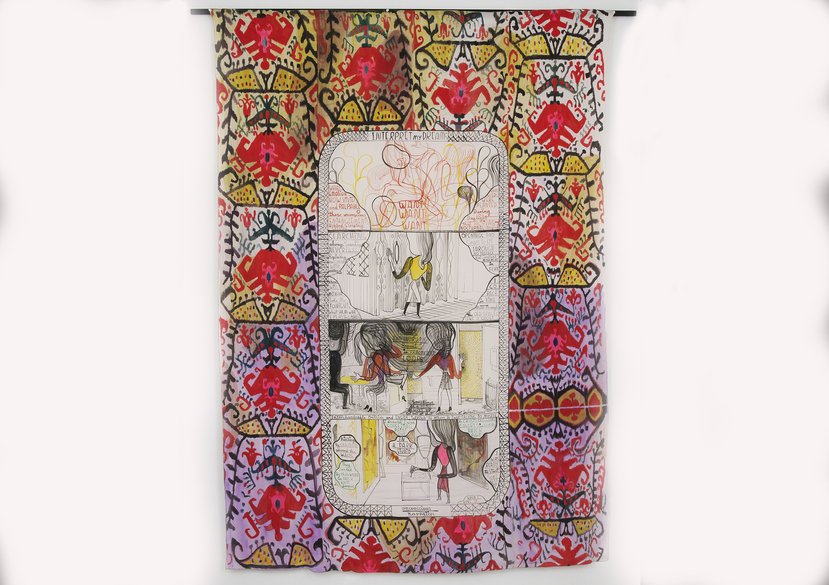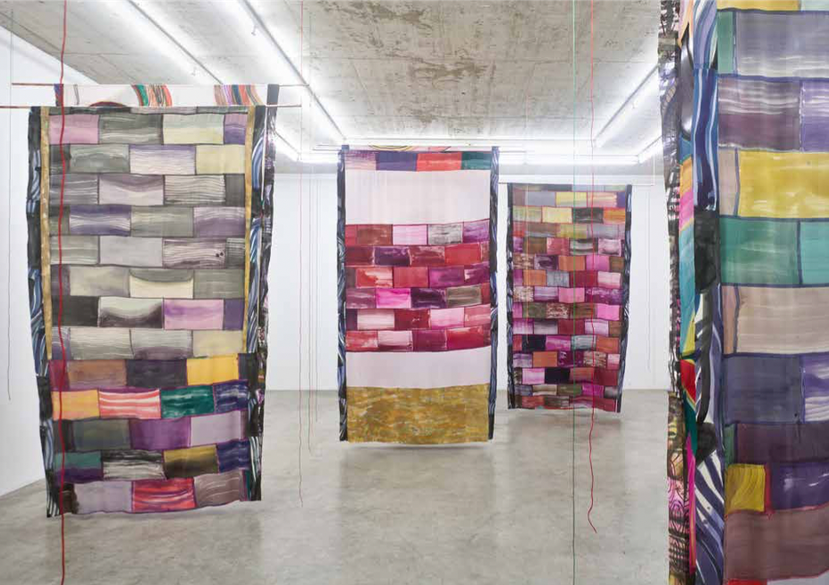
The research explores how painting can find forms that contain simultaneous reference to inner and outer worlds of lived experience and hold a number of interrelated thoughts. In the resulting works the intimate and personal are cast into the context of prevalent contemporary concerns.
At a glance
- This research culminated in a body of art works that extend the means by which contemporary painting might operate: simultaneously expanding strategies for presentation and installation (hanging free of stretchers, double sided, walk-through structures) with strategies for image-making using composites of text, drawn image and pattern to articulate internal narratives and the contemporary lived experience.
- The research explores the ways the intimate can become material for artwork. It takes the principles of écriture feminine (Cixous, Irigaray), and its proposal that new languages can be developed to articulate life experience, particularly from a feminine perspective, and applies them to painting, setting up a conceptual relation between painting-thinking-speaking.
Key details
Gallery
More information
Research methods & questions
The research aimed to reset the rules of traditional processes. Fabric works are not new, but through the use of multiple, drawn images, diaristic writing, quotation and pattern the work develops an idiosyncratic visual language. This prompted material decisions, rejecting painting’s ‘givens’ such as the stretcher format or flat work installed on a wall.
Silk’s lightness is equivalent to the immediacy of work on paper and references to intimacy/femininity/domestic material are appropriate to the subject matter.
The research focuses on the drawn image’s contemporary agency and value for recording that which we cannot digitally record - our ‘mind’s eye’ visualisations. Relationships between the personal and technology for example, phones, texting or social media imaging structures locate this painting practice within the context of the contemporary experience.
This testing of image structures and text/image ‘sharing’ is significant within the sphere of contemporary painting and drawing practice and the wider sphere of contemporary art. Questions of the individual voice’s relationship to the political and contemporary everyday, as exercised in the painted works, hold currency for a wide intergenerational audience.
The project
Excerpt from Unearth That Which is Hidden essay by Rozsa Farkas to accompany Emma Talbot: Sounders of the Depths exhibition at GEM Kunstmuseum, The Hague:
"A lack of determinism, not knowing where one is going, but instead feeling out where one is, offered by Philippe Pignarre and Isabelle Stengers book Capitalist Sorcery: Breaking the Spell as philosophical locus, is reflected not only in Talbot’s approach to making, but is also referenced explicitly in the exhibition’s title, Sounders of the Depths. In being a sounder of the depths we can find our own agency:
"Sounders of the depths should not invent words that are to be understood as beyond division, as if they were authorised by a transcendence in the presence of which everyone must kneel: that is the role of the prophet, or his substitute today, the theorist. The words to be created ought rather to serve as antidotes to what transforms divergences into oppositions, what makes us dream of a homogeneous unanimity, of a judgement that will at last confer on history the power to recognise those who had seen correctly." Isabelle Stengers and Philippe Pignarre, Capitalist Sorcery: Breaking the Spell
In the work of the same title, Sounders of the Depths, a series of drawings refuses to be fixed – to be fixed to the wall or to provide fixed representations – these pieces hover between being a dream diary and series of automatic drawings. It is important to state that the occupation of uncertainty is far from a quest for nonchalance, instead it is an active process by which to really see. The hope is that when one sees, as opposed to accepts, other possibilities can begin to emerge.
The opening up of potential, of becoming, of making beyond presumed forms, is a well¬trodden ground in feminist writing. Both Hélène Cixous and Luce Irigary are cornerstones for the artist in thinking about form in her own work, or rather about process, as the form of the drawings are often initially unknown and the result of open experimentation. Cixous argued to put the unthinkable into words, here Talbot puts that which is held in the subconscious firmly out of relief, and into the forefront. There is an unfaltering commitment throughout this exhibition, from the artist herself, to place in full view the questions and thoughts that consume her, as well as an urging for us to find the ability to isolate our own.
"She falls back into a depth of thought: that goes right to the bottom of things, beyond appearances, would there¬ fore be difficult to penetrate because it is more internal, more secret, but also more durable because it is not subject to the fluctuations of the sensations, of the perceptible world. From time to time it is worthwhile to flatten out this “inside” (of the spirit), bring it to the surface." Luce Irigaray, Marine Lover of Friedrich Nietzsche
On entering the exhibition we are confronted. Confronted with an image central to our existence but often hidden, Your Birth ¬ the epic historical moment you can’t remember. Birth here is timeless and placeless, like visualising an ancient song, the impossibility of remembering our first stage into the world renders the sculptures almost¬ alien. The woman giving birth, atop of a placenta painting on silk, the baby, the placenta and the two lyres that are also wombs create a network with one another. This constellation of painting and objects is on top of a pink almost¬ clinical platform and again the extra¬terrestrial is imbued. The tentacle arms and tiny feet of the figures seem off¬human, but also, are perfectly in line with a drawing style developed by the artist over the last decade. As with all Talbot’s work across many mediums – drawing, sculpture, painting, installation – everything begins as a drawing. Drawing is the most immediate mark making, mode of representation, act of recording (early songs amongst everything else) and perhaps the easiest way to access making through feeling¬ out, without preconceived expectations of what will be made. In keeping with a draftsperson’s mode of creating, the sculptures stand strong as drawings in 3D."
Activities
2020
- Emma/Ursula Petra RInck Galerie Dusseldorf (solo)
- The Age of The Reaper, Galerie Onrust Amsterdam (solo)
- When Screens Break Eastside Projects, Birmingham(solo)
- Dundee Contemporary Arts (solo)
- Kunsthalle Geissen Germany (solo)
2019
- Mimosa House London (group)
- Art Night Commission, William Morris Gallery London (solo)
- Sounders of the Depths, GEM Kunstmuseum, The Hague (solo)
2018
- From the Inside Out, Drawing Room London (group)
- John Moores Painting Prize, Walker Art Gallery, Liverpool (group)
- Virginia Woolf, Tate St Ives, Pallant House, Fitzwilliam Cambridge (group)
- Journeys Through The Wasteland, Turner Contemporary, Margate (group)
- Emma Talbot Nicolas Krupp, Basel (solo)
- 21st Century Sleepwalk, Caustic Coastal, Salford(solo)
- CONDO NY
2017
- Stained with Marks of Love, Arcadia Missa CONDO London & AM NY (solo)
- Open Thoughts, Neuer Aachener Kunstverein, Aachen (solo)
- The World Blown Apart Galerie Onrust Amsterdam (solo)
- Art Rotterdam
- Art Düsseldorf
- Assembly House Leeds
2016
Recognition
Max Mara, Whitechapel Gallery and Collezione Maramotti are delighted to announce Emma Talbot as the winner of the Max Mara Art Prize for Women
This prestigious prize supports UK-based female artists who have not previously had a major solo exhibition. Awarded in alternate years since 2005, it is the only visual art prize of its kind in the UK. As the winner Talbot will spend six months in Italy on a bespoke residency planned for later this year, creating a new body of work to be shown in 2021 first at the Whitechapel Gallery and then at the Collezione Maramotti, Reggio Emilia, Italy.
Klimt through a feminist lens: Emma Talbot wins Max Mara art prize
Artist of ‘radiant drawings’ and epic sculptures wins for her project to overturn negative view of older women expressed by famous 1905 painting
Emma Talbot wins the Max Mara Art Prize for Women.
The artist uses drawing, painting, installation and sculpture to explore narratives of power through a deeply personal lens
Meet the 2020 Max Mara Art Prize winner, Emma Talbot
Emma Talbot is the 2020 winner of the prestigious Max Mara Art Prize for women, set to spend six months in Italy on residency. We meet her to find out what's next
Eighth Max Mara Art Prize for Women goes to Emma Talbot
Emma Talbot has won the eighth Max Mara Art Prize for Women, a biennial award that supports UK-based female artists who have not previously had a major solo exhibition. Administered by Max Mara, Whitechapel Gallery, and the Collezione Maramotti, the prize comes with a six-month residency in Italy that will culminate with Talbot staging an exhibition at the Whitechapel Gallery in London and the Collezione Maramotti in the Reggio Emilia region of Italy.
Emma Talbot is the newest winner of the Max Mara Art Prize for Women
Emma Talbot wins Max Mara art prize for reimagination of Klimt
Eastside Projects ONLINE: Live Studio Visit: Emma Talbot
Thursday, 14 May 2020
Sounders of The Depths GEM The Hague Catalogue for the exhibition (attached)
Kunstform Feature (attached) in German
CONDO Emma Talbot @ Arcadia Missa, Fruit of The Forest 30.1.17
Art News CONDO Arcadia Missa and VI,VII at Arcadia Missa 2.1.17
CONDO something curated, 4.1.17
Emma Talbot : CONDO, Critics Guide, Rosanna Mclaughlin, Frieze 17.1.17
CONDO Flash Art online 27.1.17
Fruit of The Forest Artists Interview Emma Talbot, Federica Tattoli February
Kunstforum, feature on Emma Talbot by Magdalena Kröner, September 2016 issue
Art Review, 'The Mountain' commissioned artist pages with introduction by Paul Gravett, September 2016 issue
'The imaginative inner life of the comic artist' in The Guardian, Australia on 'Comic Tragics: The Exploding Language of Contemporary Comic Art' curated by Robert Cook, Art Gallery of Western Australia, Perth, Australia, 18.04.16.
The Monologuist/Emma Talbot/Comic Tragics by Anders Brekhus Nilsen (USA) writing on themonologuist.blogspot.co.uk about 'Comic Tragics: The Exploding Language of Contemporary Comic Art' curated by Robert Cook, Art Gallery of Western Australia, Perth, Australia, 18.04.16.
'unraveling the knots at the freud museum' review in ID/Vice by Rózsa Farkas, 06.04.16
Awards
- 2020 Max Mara Art Prize for Women, Whitechapel Gallery London and Collezione Maramotti Italy
- 2016 MAC International Ulster Bank Prize, Finalist
Ask a question
Get in touch to find out about School of Arts & Humanities research projects.
soah@rca.ac.uk






















